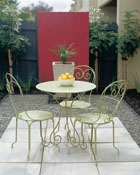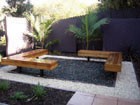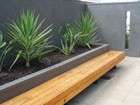DESIGNING SMALL GARDEN SPACES
Designing small gardens can be a challenge. Good planning is the key, which of course applies to all garden design. But in a small garden there are additional issues to think about.
Simplicity
In a small garden simplicity is the key. Without it small gardens can fail miserably.
Simplicity does not mean boring either. A simple flowing landscape helps promote space.
-
Keep the plant palette minimal, keep colours restrained, with an emphasis on foliage and form for year round interest.
-
Follow the rule of ‘less is more’. Over designed, cluttered spaces look busy and contrived.
-
The secret is achieving a balance and symmetry in the garden.
-
stick to a strong design theme. Follow through using plants and materials that fit that style. Avoid creating a mish mash of ideas.
-
Pay attention to details, choose high-quality materials and make sure the work done by a skilled professional.
-
Use strong, simple shapes for garden beds. Geometric shapes work well. This allows for scope for more decorative, dynamic elements you can add into the garden such as sculpture and water features.
 Proportion
Proportion
Many people think small gardens need small plants, well the opposite is true. Well-chosen large plants in a small garden appear to enlarge the space rather than diminish it.
This principal also works on the ground plane with paving and other hard landscaping features. A larger format paver will make the space appear larger than compared to lots of smaller sized cobbles or bricks .
-
Keep outdoor furniture at an appropriate size for its space. Avoid bulky furniture. Use a few large simple pieces of furniture in place of several smaller pieces.
-
Choose plants that will not overwhelm or grow too big for the space and eventually look out of place for the scale of the site. Vertical, narrow foliage allows plenty of light to filter through without causing over crowding.
-
Built structures such as pergolas should be carefully designed to sit effortlessly within the landscape and connect visually with the architecture of the house.
-
Generate a feeling of space by laying pavers or garden beds on a 45 degree angle across the garden. This technique draws the eye along the lines to the garden edges and gives the illusion of length.
-
To make a garden appear longer, place larger plants in the foreground and set increasingly smaller ones behind.
 Unity
Unity
There should be a link between house and garden as the architecture is a particularly prominent backdrop in a small garden. There are many ways to unify the two.
-
Create continuity between the interior and exterior of the house by taking materials such as paving, tiles or timber from the inside out into the garden. This idea works particularly well if you have a courtyard or patio immediately off the kitchen or living area.
-
Visually link the interior with the outdoors by introducing colour used in furnishings with foliage or flowers planted in the garden.
-
Unify the planting in a small space by repeating groups of plants or keep to a single colour theme.
-
Take a look at the external architecture of the house and repeat some of these basic shapes in the garden.
-
Most small gardens are viewed from the house, so think about creating visual focal points viewed from within the house. Whether it’s a very special plant or an expensive piece of sculpture.

Functionality
Form follows function in a small space. In tiny gardens, where space is limited, every inch of it must be used to advantage. It needs to provide a useful function as well as look aesthetically pleasing.
-
Use elements that have a dual purpose, such as planters that double as seating. Or create storage inside a closed timber bench seat.
-
Include plenty of seating. Make sure paving or decking areas are big enough to include a table and chairs. Bench seating is the best way to deal with tight areas. They tend to sit on the perimeter of paving so it does not intrude too much.
-
Some amazing dramatic effects can be created using lighting. By adding lighting you can utilize the garden after dark. Avoid putting too much light onto boundaries. Feature trees, water features and gazebos will benefit from subtle lighting.
By following some of these simple rules, your garden will feel comfortable, not cramped. You’ll have an intimate space that suits all your needs.
Sandra is an award-winning landscape designer based in Auckland.
Sandra Batley Dip LD
FLOURISH


